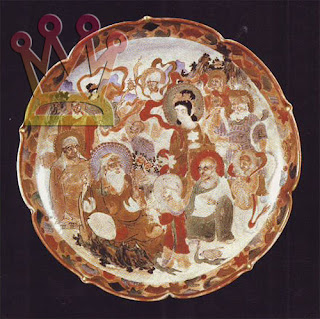Showing posts with label Antique Ceramics Found in Indonesia. Show all posts
Showing posts with label Antique Ceramics Found in Indonesia. Show all posts
Antique Ceramics Found In Indonesia-Dish Faience
Dish,faience, decorated in polychrome colours. The dish is decorated with banner and emlembs with a date 2 July 1921 above a text which reads " To Frits Eijken from Delft's citizens ". The basic is fully glazed except for the footrim, with a Delf 's factory mark.
Diameter 36 cm Delf's ware
Twebtieth century.
Taken from:The Adam Malik Ceramic Collection
Antique Ceramics Found in Indonesia " Japanese And European Ceramics "
Plate.no.1.front
Plate no. 1.back
Plate.no.2
JAPANESE AND EUROPEAN CERAMICS
Coinciding with the establishment of the Sultanates in Demak (central Java) Banten (West Java), some places in South Sulawesi and the moluccas in the sixteenth century, European marchants arrived looking for trade items, specific amongst there itemms desired were spices. The Europeans also marketed Chinese ceramics.
Among those Europeans were the Dutch merchantss consolidated in the V.O.C. (Verineegde Oost Indisch Compagnie) who later ordered porcelain with the V.O.C. monogram on it from japan in the seveteenth century (pl.no.1). Porcelain with the V.O.C. initials in polychrome enamels and the year 1728 on it was also made in China.
Besides the blue and white decorated Japanese ceramics there are polychromes and celadons (pl.no.2), Japanese ware, including polychrome and the blue and white ceramics dating from the eighteenth to the early twentieth centuries were very much sought after as dinner ware or decorative objects.
European ceramics of the seventeeth century which reached Indonesia were only pieces used in the every day life of the European merchants; for example the blue and white Delf porcelain from the nederlands. Only later, in the nineteeth century., did polychrome enamelled dishes become popular. They were popularized by a group of Indonesia who wished to imitate the European way of life.
Antique Ceramics Found in Indonesia - South East Asian Ceramics
 |
| Plate.1 |
 |
| Plate.2 |
 |
| Plate.3 |
South East Asian Ceramics
Among South East Asian wares found in Indonesia we distuinguish Khmer ceramics pl.1 from the ninth to the fourteenth centuries, Vietnamese or Annamese ceramics from the fourteenth to around the eigtteenth centuries and Thai ceramics from the fourteenth to the sixteenth centuries 13.
Current with the end of the Yuan dynasty, Indonesia was flooded with ceramics from Vietnam and Thailand, the latter known by the name of the kilns : Sukhoi and Sawankhalok.
It might be possible that South East Asian ceramics came into the market labelled as " Chinese ceramics " so that people would not know these wares originated in Vietnam and Thailand.
According to Mr. Nikn Musikagama. Director of the Museum at Sukhothai (1978), the kiln in Vietnam and Thailand began producing at the end of the Yuan dynasty and produced until approximately the sixteenth century. It is said that the production of ceramics at the Sukhothai kilns during the fourteeth and fifteenth centuries was supported by the many orders from outside the Sukhothai kingdom itself. The market might have been South East Asia including Indonesia.
Vietnamese ceramics of the blue and white ware called " ming Korea " by Indonesia dealers until 1970. This error was probably due to misinterpretation. The blue and white wares in the collection are very finely made with an unusual designe and shape (see the covered tureen pl.2).
The covered boxes and waterdroppers which are very popular in Indonesia are also charming. Besides the blue and white wares, there are also polychrome and monochrome pieces. The main characteristics of Vietnamese ceramics are their cream colored fine body with a nearly cut foot and a base often covered with a brown slip. The rim of dishes and bowls are often unglazed indicating a mouth to a mouth firing. Vietnamese wares were probably made around Hanoi,probably in Namsach Phu and Battrang.
A characteristic of Sawankhalok ceramics is their gryish body with black spots often burnt red unglazed surface. We often see a black right at the base. In addition to the celadon types of the Sawankhalok wares (pl.3, one also finds in Indonesia underglazed black pieces, brown monocrhomes and brown and white wares.
Antique Ceramics Found in Indonesia:Celadon Jar
Celadon jar with two handels and flower and flower decoration. Diameter
15.5 cm, 14/16th centuries, Sawankhalok. The term kelapa for bulbous
jars with two ringhandels seem to have originated in Sumatra where the
name of these jars is karambi or coconut in local dialect. They are indeed known to be used as container for coconut oil.
Antique Ceramics Found in Indonesia : Plate-2
ANTIQUE CERAMICS FOUND IN INDONESIA
Antique Ceramics Found In Indonesia: Plate - 1
 |
| ANTIQUE CERAMICS FOUND IN INDONESIA |
Dish,with foliated rim and finely crackled glaze.
Decorated in polychome enamels and gift and a blcak square mark on the glazed baze. Diameter 31 cm,Satsuma type, 18th/19th centuries Adam malik Collection.
 |
| ANTIQUE CERAMICS FOUND IN INDONESIA |
Dish, faience
with a cream craclked glaze and black enamels. In the center within a
circle is a star and half moon sourrounded by eightpanels contining
Arabics letters, which are the names of the four angels, Michael,
Gabriel, Isrofil and israel, alternated by the names of prophet's
friends. Abu Bakar, Ali, osman and Umar. On glazed base in raised
circles is a crest above the writing " Made in germany ", and a
key-shapped stamped mark. Diameter 23.5 cm, 19th/20th centuries. German
ware.











